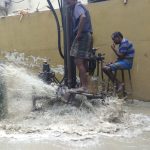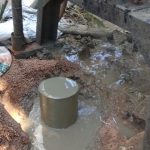Steps involved in process of constructing a new borewell
Before getting into a deep understanding of each step involved in constructing a new borewell, let us see an overview of the entire process in 3 steps;
Now let us discuss the steps involved in this process in detail.
1. Analysing the availability of water
Groundwater explorations are described in many ways in the market such as borewell survey, geologist, water diviner, groundwater scientist, Hydro-Geologist and many more terms but basically, groundwater explorations are routed into two major groups.
- Water diving or water dowsing
- Scientific groundwater exploration
To obtain reliable data, geologists conduct surveys using Earth resistivity metres, either via resistance check-up or self-potential check-up, based on the location and amount of land present.
- Resistivity probing
- Geophysical mapping
- Groundwater modelling
The underground water is extracted through tube wells. They are
- Deep Borewell : A deep borewell is more than 30 metres below ground level and has a casing diameter of 6 inches or more.
- Shallow Borewell : Borewells that are less than 30 metres deep.
Looking for the best borewell company for the drilling of new borewell at economical price?
2.0 Construction of borewell
For suggestions of deep tube wells, the State Government’s Geological Department or Central Ground Water Board / Public Health Engineering department should be consulted. Sinking deep tube-wells rather than open-wells where the “normal-water-table” is at a deeper depth would be more cost-effective and desirable.
2.1 Choosing a good drilling contractor
Drilling contractors should have prior work experience and be familiar with the geology of the area. The officer/supervisor, in collaboration with the contractor, should survey the existing wells in the region, as this will provide crucial information about the following:
- Typical yields and water quality
- Which aquifer to tap into
- Trends in well design and construction
- Prior drilling success rates.
Selecting Type of Well there are two main types of wells, each distinguished by the diameter of the borehole. The two types are bored wells and drilled wells.
We do new borewell drilling on a contract basis with professionals and experienced workers
2.2. Choosing a site for well
The well’s safety and performance will be affected by its location. The majority of impurities enter the well through the casing’s top or exterior. Sewage or other impurities may seep into the aquifer through the earth surface’s higher layers. The below-given points must be ensured;
- Cleaning, testing, monitoring, maintenance, and repair of the well are all possible.
- The well is up-slope and as far away as possible from potential contamination sources such as septic systems, with the terrain surrounding it sloping away from the well to avoid any surface runoff from gathering or ponding.
2.3. Trial boring
Before the pipes are sunk, stratum samples are analysed for yield and water samples are gathered for analysis. The area of strainer required for the quantity of water required and the strata in which the strainers should be situated are determined based on the data obtained.
2.4 Water samples for analysing
Water should be drawn from as deep as possible for a large water supply to minimize the risk of bacteriological contamination that can occur when water is drawn from the higher strata. Deep-well water is more likely to be bacteriologically pure. Because deep-well water may include dissolved pollutants, it’s best to avoid such situations by prior and proper screening and examination of the sample.
2.5. Completing the well
After the well has been bored and the necessary equipment has been installed, there are three more procedures to complete before the well may be used. These are the following:
- Developing the well.
- Conducting a yield test.
- Disinfecting the well.
2.6. Yield test
yield test is important because it gives the information of:
- Rate at which to pump the well.
- Depth at which to place the pump.
3. Borewell Endoscopic Camera Scanning
Estimation for Endoscopic Camera Scanning varies from Rs 1500 to Rs 3500 based on depth and distance. Borewell Camera Scanning is one of the most recent technologies for directly viewing the borewell after drilling by inserting a specialised geological waterproof camera inside the borewell to clearly understand the rock formation, the number of sources through which we are getting water, whether there is any silt or boulders present, whether the casing pipe is properly inserted, and many other geological factors. This step is then followed by Motor selection and Installation.
The HP of a water pump is calculated using two variables.
- Height of total lift of water.
- Required flow.
Thus, we have come to the conclusion part of the process, most important point to remember is always consult and trust a best Borewell service provider, like us.





